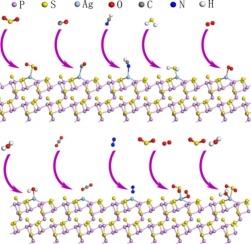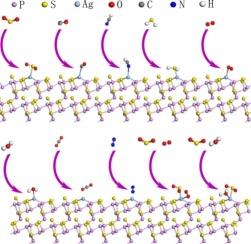Ag-doped P3S2-I monolayers: selective and robust toxic gas detection in ambient environments
IF 6.9
2区 材料科学
Q2 CHEMISTRY, PHYSICAL
引用次数: 0
Abstract
The sensing capabilities of pristine and Ag-doped P3S2-I (Ag-PS) monolayers toward toxic gases such as SO2, CO, HCN, and H2S were investigated using DFT simulations. Intrinsic P3S2-I exhibits semiconductor properties but shows limited gas adsorption capacity due to low adsorption energies (Ead). In contrast, Ag-doping induces metallization (bandgap closure) and enhances surface reactivity. Ag-PS demonstrates strong chemisorption of all target gases (Ead ranging from −0.682 to −1.149 eV), accompanied by the reopening of a direct bandgap (1.269–1.398 eV). Variations in work function and optical properties further support Ag-PS’s potential for selective gas detection. Notably, Ag-PS maintains selectivity even in humid/ambient conditions (with negligible interference from O2, H2O, CO2, and N2), affirming its utility as a robust detector and scavenger for toxic gases. These findings highlight Ag-PS as a promising candidate for environmental monitoring systems, leveraging doping-enhanced electronic and optical responsiveness for gas sensing applications.


ag掺杂P3S2-I单层膜:环境中有毒气体的选择性和鲁棒性检测
利用DFT模拟研究了原始和掺银的P3S2-I (Ag-PS)单层膜对SO2、CO、HCN和H2S等有毒气体的传感能力。本征P3S2-I具有半导体性质,但由于吸附能低(铅),其气体吸附能力有限。相反,ag掺杂诱导金属化(带隙闭合)并增强表面反应性。Ag-PS表现出对所有目标气体(铅从- 0.682到- 1.149 eV)的强化学吸附,并伴有直接带隙(1.269-1.398 eV)的重新打开。功函数和光学性质的变化进一步支持Ag-PS选择性气体检测的潜力。值得注意的是,Ag-PS即使在潮湿/环境条件下也能保持选择性(O2、H2O、CO2和N2的干扰可以忽略不计),这证实了它作为有毒气体的强大检测器和清除剂的实用性。这些发现突出了Ag-PS作为环境监测系统的有前途的候选者,利用兴奋剂增强的电子和光学响应性用于气体传感应用。
本文章由计算机程序翻译,如有差异,请以英文原文为准。
求助全文
约1分钟内获得全文
求助全文
来源期刊

Applied Surface Science
工程技术-材料科学:膜
CiteScore
12.50
自引率
7.50%
发文量
3393
审稿时长
67 days
期刊介绍:
Applied Surface Science covers topics contributing to a better understanding of surfaces, interfaces, nanostructures and their applications. The journal is concerned with scientific research on the atomic and molecular level of material properties determined with specific surface analytical techniques and/or computational methods, as well as the processing of such structures.
 求助内容:
求助内容: 应助结果提醒方式:
应助结果提醒方式:


